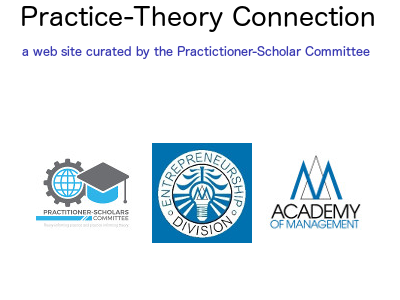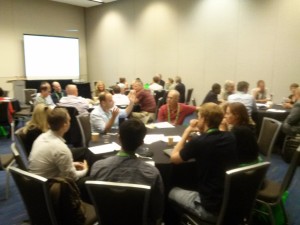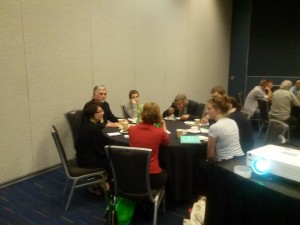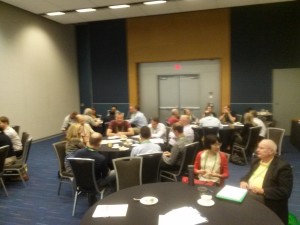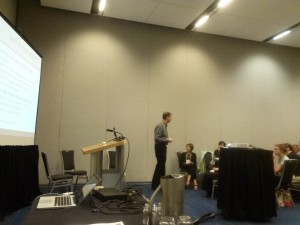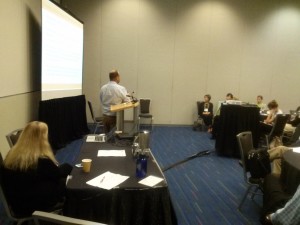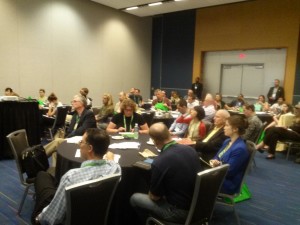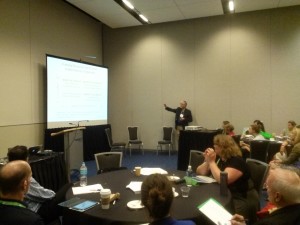The “Crossing the Theory-Practice Chasm” professional development workshop was held on Friday, August 7th, 2015 during the 2015 Academy of Management (AOM) annual meeting in Vancouver, British Columbia, Canada.
The goal of the professional development workshop was to explore the divide in academia between theory and practice. 30-40 practitioner scholars, scholarly practitioners, and pure scholars convened to surface the relevance of bridging the divide, as well as explored mechanisms to move into a regularly repeated sequence of theory informing practice, and practice informing theory – through research.
The PDW consisted of:
- Several short presentations (to get the discussion going)
- Discussions via breakout sessions
The short presentations were:
- Rigor vs. Relevance; Research Distribution Channel Model (Roxanne Zolin)
- Knowledge value chain — translating research into publications and pedagogy (Tom Mierzwa)
- Providing scholarly research that helps the practitioner (Gilberto Sarfati)
- Joining phenomena to theory; translating practice knowledge into scholarship (Joel West)
- Research questions of interest (Michael Begelfer)
The slides used during the opening of the PDW can be accessed via the link below:
[ theory informing practice and practice informing theory ]
Below are notes (from the breakout sessions / tables) and pictures from the PDW.
 Note-taker: Tom Mierzwa
Note-taker: Tom Mierzwa
Arguments that the main problem for practitioners failing to benefit from the research being done in the academy were discussed:
- The inability of practitioners to readily gain access to its publications.
An inability to understand its meaning even when accessible.
A lack of knowledge transfer and utilization channels that would bridge the world of research and the world of practice.
An absence of incentives for academic institutions to dedicate resources to translating research with practice implications. - Ideas for addressing these issues included:
Develop a research needs inventory that would be generated by practitioners (rather than relying only on research topic choices made exclusively by academics).
- Interpret forces for and against the idea that research agendas can be (or should be) generated from practitioners. Map out these forces in a force field analysis to show forces favoring such an initiative along with ways to strategically strengthen those forces. Then map out the forces limiting such an initiative along with ways to strategically overcome those forces.
- In order to get a better handle on the pattern of research being done in entrepreneurship, identify the trends on entrepreneurship research topics (via publications?) (via grant $$$ allocated for research?) (via awards given to entrepreneurship initiatives?). This could be analyzed on a longitudinal basis to reveal how emphasis on research topics has evolved. Recognizing this pattern, shifts in research agendas could be made to emphasize greater consideration of practice implications from research.
- Have practice-based associations or institutions (e.g., SHRM, or others like them sponsoring entrepreneurial growth) serve as evaluators of research relevance in a given domain of practice.
- Develop a ranking system that ranked journals by their impact on practice (not clear what the metrics for this would be, but measures like the number of practice-related articles, the form of communicating research with practice implications, plus others would be ways to look at this).
- Debunk “fad” ideas and theories with research that shows the fallacy of those fads. This might be a regular feature in a selected practice-related publication to show how legitimate research actually mattered for interpreting the value of a fad idea.
- Develop an online forum that would translate research results in “Wikipedia-like” fashion so that it was readily readable, accessible and understandable by practitioners.
- De-construct research and theory inputs that formed the basis of best practices or best products. Have case studies focus on not just the “story” of a business, entrepreneurial venture, or management practice, but include ways that research results contributed to the value of an improved best practice or best product.
- Look for ways to leverage the “entrepreneurial outreach” mission of universities. Make a case for the value of translating research knowledge to university stakeholders in their surrounding community of practice. This has been done in a classic way through institutions like the Agricultural Research Service and land grant universities.
- Have journal articles include keywords for practice implications; construct journal article abstracts to include practice implications.
- We need to go beyond publication to communicate with society
- How do we get the university accountable? Publication shouldn’t be accountability
- Metaphor fashion industry – It is missing the middle people – to translate academy to larger industry
 Note-taker: Tom Walter
Note-taker: Tom Walter
- One tangent was a discussion about to what extent evidence based research is necessary for practitioners because of the availability of shared learning channels and the lag time of research
- Another branch was a discussion about Gilberto’s thought of “niche publications”. If the publication was available in print and electronically this option would be a bridge. It would require effective marketing to create awareness and pull through.
- A discussion focused on how it appears that most entrepreneurial academics are not entrepreneurial in their approach to transferring knowledge to practitioners. ( I enjoyed this. It is one thing for a possessive research approach for other disciplines. But how can an academic have an entrepreneurial passion if they don’t focus on helping entrepreneurs deal with problems today? Whether it is Vistage, Entrepreneurs Organization (EO) or the Small Giants Community, there are many options for entrepreneurs to solve pains by consulting with each other rather than rely on scientific proven research. Therefore, research may be rigorous but is not relevant.)
Note-taker: Joel West
- Consultants often present academic ideas (at a higher price) to industry. On the one hand, this suggests that academia should do more to be directly relevant. On the other hand, consultants provide a service (including reaching out to industry and repackaging) that academics cannot or will not do.
- If we want to reach managers, we should find out what conferences they attend and engage them there
- There is always the problem that many managers don’t think long term — because they lurch from crisis to crisis — and so ideas about how to improve long-term performance will fall on deaf ears. As we know, organizations need an optimal level of slack to improve their performance.
- YouTube is becoming an increasingly effective way to communicate business ideas to managers
- One way to better understand managerial problems is to work with bigger companies to do research using their data. Some have data they would love to share (although it takes time to get executive approval for access to the data)
